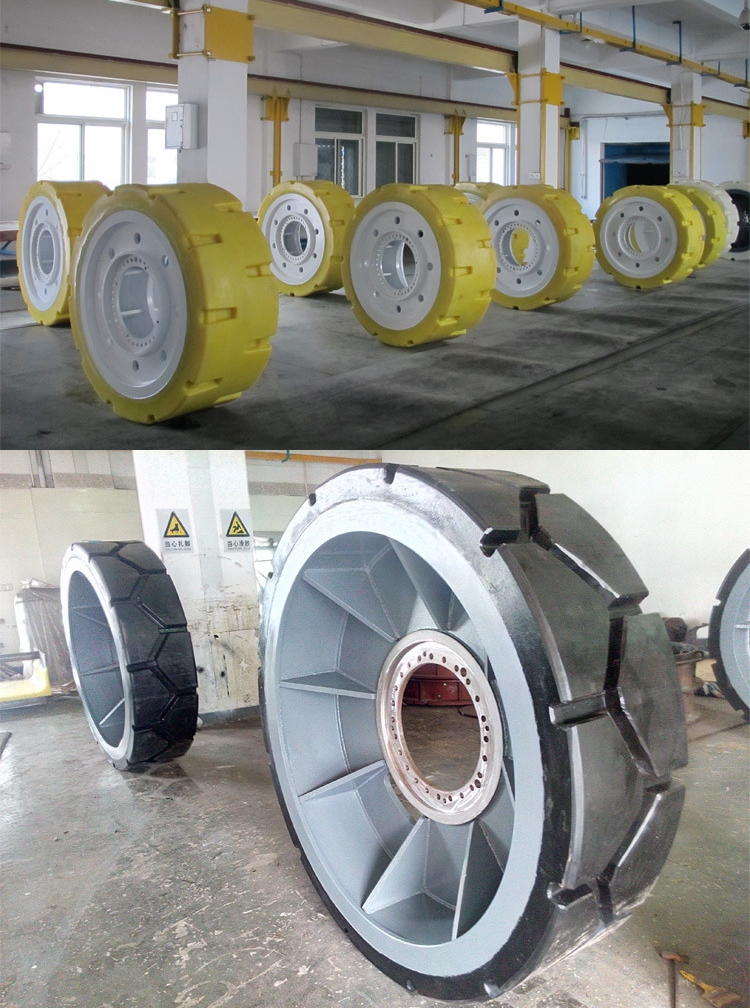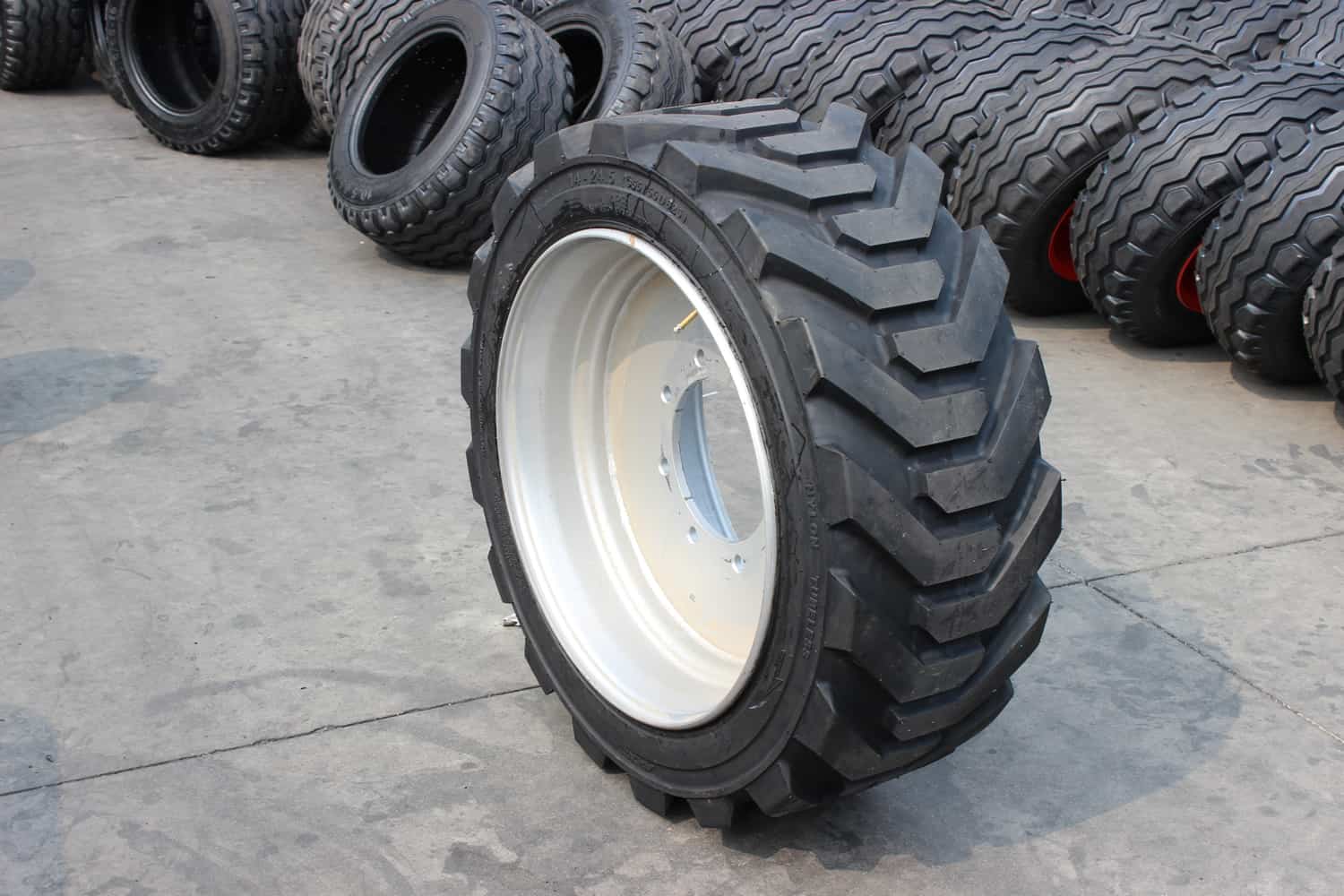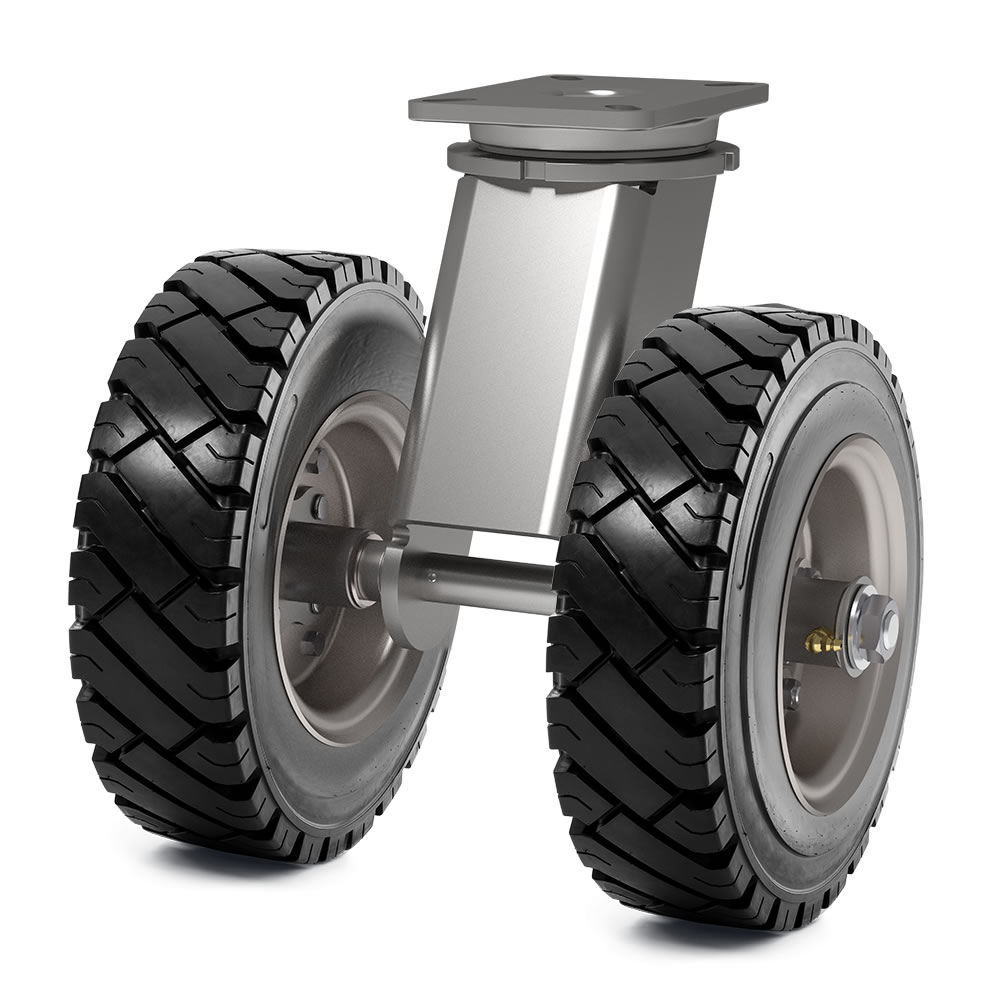China PU tires, polyurethane tire for sale from SinoTrailers.

Polyurethane’s wear-resisting performance is 2-10 times better than natural rubber.
Pouring method to make polyurethane tires from polyurethane elastomer is the basic way to simplify the production process from solid processing to liquid processing. The method integrates mixture, molding, and sulfuration.
Wear test of PU tire and all-steel radial tyre (the rubber tire)
The test was made by a US company, the vehicle was running 10,000 kilometers with PU tires and all-steel radial tyres separately. The test result showed:
- PU tires saving fuel 9.95% compare to all-steel radial tires
- Wearing consumption of PU tires is 51% lower than that of all-steel radial tires
- PU tires have a longer working life
- Weight of PU tires is 22% lower than that of the rubber tire
- Interior heat generated is 54% lower
- Rolling resistance is 35% lower than that of the rubber tires
- Brake performance of the all-steel radial tire is 6% better than that of the polyurethane tire
- The maneuverability of both tires are the same
Differences between polyurethane tire and rubber tire
| Item | PU Tire | Rubber Tire |
| Carrying capacity | Good | Poor |
| Cutting resistance | Good | Poor |
| Tear resistance | Good | Poor |
| Wear resistance | Good | Poor |
| Traction performance | Poor | Good |
| Braking performance | Poor | Good |
| Buffer performance | Poor | Good |
| Rolling resistance | Good | Poor |
| Ground trace | Good | Poor |
| High-speed performance | Poor | Good |
| Anti-skid performance | Poor | Good |
| Chemical resistance | Good | Poor |
| Environmental friendly | Good | Poor |
| Price | Poor | Good |
- The rubber material is relatively soft than the PU material
- The rubber tire vehicle is cozier than the polyurethane tire vehicle
- Rubber tire has a relatively shorter service life
- The thermal conductivity of PU material is lower, so how to dissipate the heat generated by rolling is the key point to protect the tires from being damaged by overheat
- Wear-resisting performance and tearing strength are weaker
- Has chances to burst tire when equipped in heavy-duty trucks and trailers due to its limited carrying capacity
- Production equipment of rubber tires is expensive and hard to maintain the quality consistency of the mass production
- Scrap rubber materials will be generated during the fabrication of rubber tires, and those rubber scraps are hard to recycle
- Polyurethane elastomer is the most wear-resistant elastomer
- Owns dyeability, could be put different colors
- Better homogeneity compare to rubber tire
- Easy to clean the tire sidewall via PU adhesive
- Low rolling resistance and low temperature rise during the vehicle running
- The PU tire can reduce a half consumption compare that of the conventional rubber tire
- PU tires are available for low speed with heavy-loads. If the running speed is higher, rubber tires will be the only choice
- The polyurethane tire is traceless when it is running on the ground, which makes it is suitable for in-plant use
- If the ground is wet, better to use rubber tires due to PU tires may slip

Differences from polyurethane foam filling tires
Polyurethane tires are pure polyurethane material or compound with rubber.
PU-rubber composite tires are rubber tire body with PU tire surface.
PU foam filling tires are tubeless rubber tires filled with PU foams, to make them run flat tires.
Buffer characteristic and payload capacity
The payload capacity and the buffer performance of PU tires are related to the hardness of the polyurethane.
If the hardness number is high, which means the tire is harder, shock-absorbing and buffer characteristic ability are lower, but carrying capacity is higher. So the PU tire has a suitable hardness is the key balance to take full advantage of polyurethane material.
Normally shore A hardness of rubber tires is 67~75, and that of PU tires is 83-95. If the hardness of polyurethane tires is lower than 83, the physical properties of the tire will accelerate to drop.
To discover the full potential of the PU tires, we can even produce hardness 95 tires but barely offer buffer capability from such tires. In some conditions, 95 tires have 15% higher capacity than that of 83 tires, they can increase the moving ability of vehicles and reduce downtime of replacing worn tires.
Rolling resistance
The chemical composition of polyurethane material makes it has a lower rolling resistance compared to that of rubber material.
Lower resistance will increase the efficiency of battery motorized transfer vehicles and electric self-propelled modular transporter, reduce battery charging times. Frequent charges of the battery will put more workload remarkably.
At the same time, to meet with the special tire demands from the electric transfer cars, the rubber tire manufacturers are also producing low rolling resistance rubber tires. All the purpose of low rolling resistance is to improve the working life of the battery and increase the efficiency of those battery transfer carts.
Traction performance
The adhesive is significantly different between the rubber and PU when they touch the ground. Relatively soft rubber tires have a bigger contacting area with the ground, they have better traction performance than PU tires.
Different and reasonable tire tread patterns will improve the performance of polyurethane tires, only a small part of load capacity is sacrificed due to the tread patterns.
Carrying capacity
The carrying capacity of PU tires is approximate 2 times higher than that of rubber tires, and polyurethane tires not easy to crack or tear apart. Because of those two features, PU tires are widely used for heavy cargo transports.
For the past few years, loading capacity and traveling speed of different types of heavy loads vehicles are getting higher and faster, no matter they equipped with rubber tires or PU tires, all of them are overloading. Overloading means heat-generating and the heat will failure the tires.
Wear-resisting property
Rubber tires are soft and cozy, but the wear-resistance is inferior to that of PU tires. When the contact and friction happened between the tire and the ground, the polyurethane material has less chance to have scraps and debris due to the friction, so the wear-resistant life of the PU tire is 4 times higher than that of the rubber tyre.
Tear-resisting property
The cutting or tearing area will enlarge once the rubber tire generating a crack by cutting or tearing, and the enlarging of the crack will failure tires earlier than expected. PU tires will also have cracks, but the enlarging of those cracks will not happen in the tires.
Speed ability
The Achilles heel of PU tires is heating. The polyurethane material can not dissipate the heat rapidly. The upper limit working temperature of PU tires is 80~90°C, which will be easy to fatigue and flex if the running temperature is too high, which will lead to early-stage damage. But we can use a special formula(added with polyalcohol, diphenylmethane, and diisocyanate) to enable the tyre to bear up to 140°C.
So the rubber tire is better for long-time and high-speed situations. The traveling speed of diesel engine/electric SPMT and transfer cart is lower than 10 kilometers per hour, in this speed PU tires will be the better choice.
Chemical resistance
Rubber tires may swell if contact with organic solvent for a long time. Polyurethane tires are stable no matter contact with acid or corrosive solvent.
Cost performance of PU tires and rubber tires
The raw material of rubber tires is cheaper than that of the PU tire. The price difference is ranging from 25% to 50%, but the service life of the polyurethane tire is longer. So how to choose between rubber tires and PU tires depends on working conditions.
Design of the solid polyurethane tire
The main principle to design this tire is to make sure the tire will touch the ground entirely.
Liquid inert dimethyl siloxane helpt to improve the wear-resistance performance of the industrial solid polyurethane tire.

Future research of PU tires in China
- Nowadays mature PU tires are pure polyurethane material, compound PU and rubber tire is a necessary job
- Molecular designing and formula research of tread surface of PU tires
- Design of PU elastomer to reduce interior heat generated
- Improve the mechanical property, the stability of wear-resist performance of the PU elastomer in dynamic high temperature
- Enhance adhesion between the PU and the rubber
Polyurethane-rubber composite tires
The rubber tire body is made by the traditional production method, the surface is poured by polyurethane, and key technology is the adhesive using to stick both materials. This composite tire integrates advantages of the all-steel radial tire and the pouring polyurethane tire.
The electric SPMT use limited batteries, at every single charge circle, its running mileage can be increased effectively with the help of advantages of polyurethane tires.
Because of the advantages of polyurethane elastomer, many industrial vehicles are using the PU tires, no matter for construction machines, mine trucks, and agricultural vehicles, the development prospect of polyurethane tires is good.


